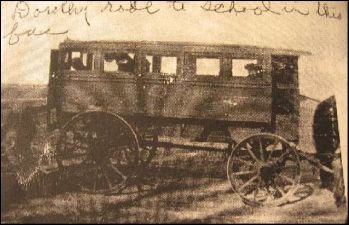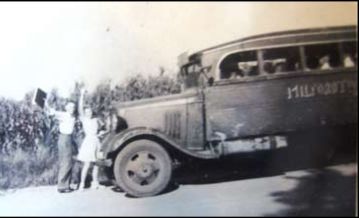
The photo is from Glen Sampson’s collection but is one of the horse drawn busses that Dorothy Sowers Bielefeldt ‘31, who grew up on the east side of Sec 8, rode in to get to school in 1931. Both she and her older sister Jeanette later taught at Milford Twp.
Adapted from Lola Tjelmeland‘47 Anderson:
I remember the first buses I rode in were very different than the ones they have now. The seats were long benches along the windows and there was a narrow bench down the center. The smallest of the children had to stradle this and sit there. It was hard sometimes not to get your wet shoes on the big kids shoes sitting on the side. I don’t know how many years we rode those till they were able to buy the busses that had seats down each side. Of course the air conditioner was turned on by opening the windows or the heater was activated by pulling your coat tighter or sitting closer to your friends.
Glen Sampson ‘43 recalls that he rode the horse drawn busses for the first three years of school and then switched over to motorized. Otis and Argle Cole were the drivers. Glen lived on the very north edge of Milford Twp.
Edit: The contracts of the horse drawn busses were rather unusual in that the folks who had the contract with the school board were listed as “haulers” but that, apparently, did not classify them as the drivers as the name listed in the paper was not necessarily the name of the driver as remembered by the students. Apparently, the driver often was the son of the hauler and often was a student at the school. Speculation is that, at that time, the school board could not make a contract with a minor but the hauler could. The hauler owned the horses and provided for their care, apparently even to the point that one driver reported that they had to take hay to school in the mornings so the horses could have hay at the noon time. This, perhaps in some instances, served as insulation for the students on the bus to use on cold mornings. Others report that the use of heated bricks served to help keep the toes somewhat warmer on these cold days. In 1912, in Grant Twp, there were haulers there for their “Union School” system that received $40 a month with the “wagons” costing about $150 each. The teachers, during the same time period, received $45 to $50 a month. Milford apparently did not have busses until the consolidation into Sec 15.

How much money was paid to the haulers in 1919 and the following years is not known but surely it cost more than what the drivers of the cars and later motorized busses received. From 1920-1923, students were hauled in 6 wagons and 2 busses. See page 89.
For, apparently, two school years (probably fall of ‘31 through the spring of ‘33) private automobiles were used as transportation. One student remembers riding in a fine Hudson automobile to and from school. This was at the time Milford Twp had as many as fourteen drivers. With 191 students in the Fall of 1927, there were “fourteen bus routes” used. Then the exclusive use of motorized busses began and the horse drawn busses were sold in 1935.
When the concept of motorized school busses was catching on very rapidly, in the mid thirties, it was the standard procedure for the schools to own the bus body and the “hauler”, or driver, would own the truck chassis. At one time during this time frame, Milford owned four bus bodies and, during the summer, these hung suspended from rafters in the bus barn on the School property. Then , in the Fall, when there was a need for student transportation, a farmer would take the grain or stock box off his truck frame and go to the bus barn and bolt on the bus body. This practice had ended by 1940.